The best Plausible alternatives & competitors, compared
Oct 08, 2024

On this page
- 1. PostHog
- What is PostHog?
- Key features
- How does PostHog compare to Plausible?
- Why do companies use PostHog?
- 2. Fathom
- What is Fathom?
- How does Fathom compare to Plausible?
- Why do companies use Fathom?
- 3. Matomo
- What is Matomo?
- How does Matomo compare to Plausible?
- Why do companies use Matomo?
- 4. Heap
- What is Heap?
- How does Heap compare to Plausible?
- Why do companies use Heap?
- 5. Piwik Pro
- What is Piwik Pro?
- How does Piwik Pro compare to Plausible?
- Why do companies use Piwik Pro?
- 6. Umami
- What is Umami?
- How does Umami compare to Plausible?
- Why do companies use Umami?
- 7. Google Analytics
- What is Google Analytics?
- How does Google Analytics compare to Plausible?
- Why do companies use Google Analytics?
- Is PostHog right for you?
1. PostHog
- Founded: 2020
- Similar to: Heap, Matomo
- Typical users: Engineers and product teams
- Typical customers: Mid-size B2Bs and startups
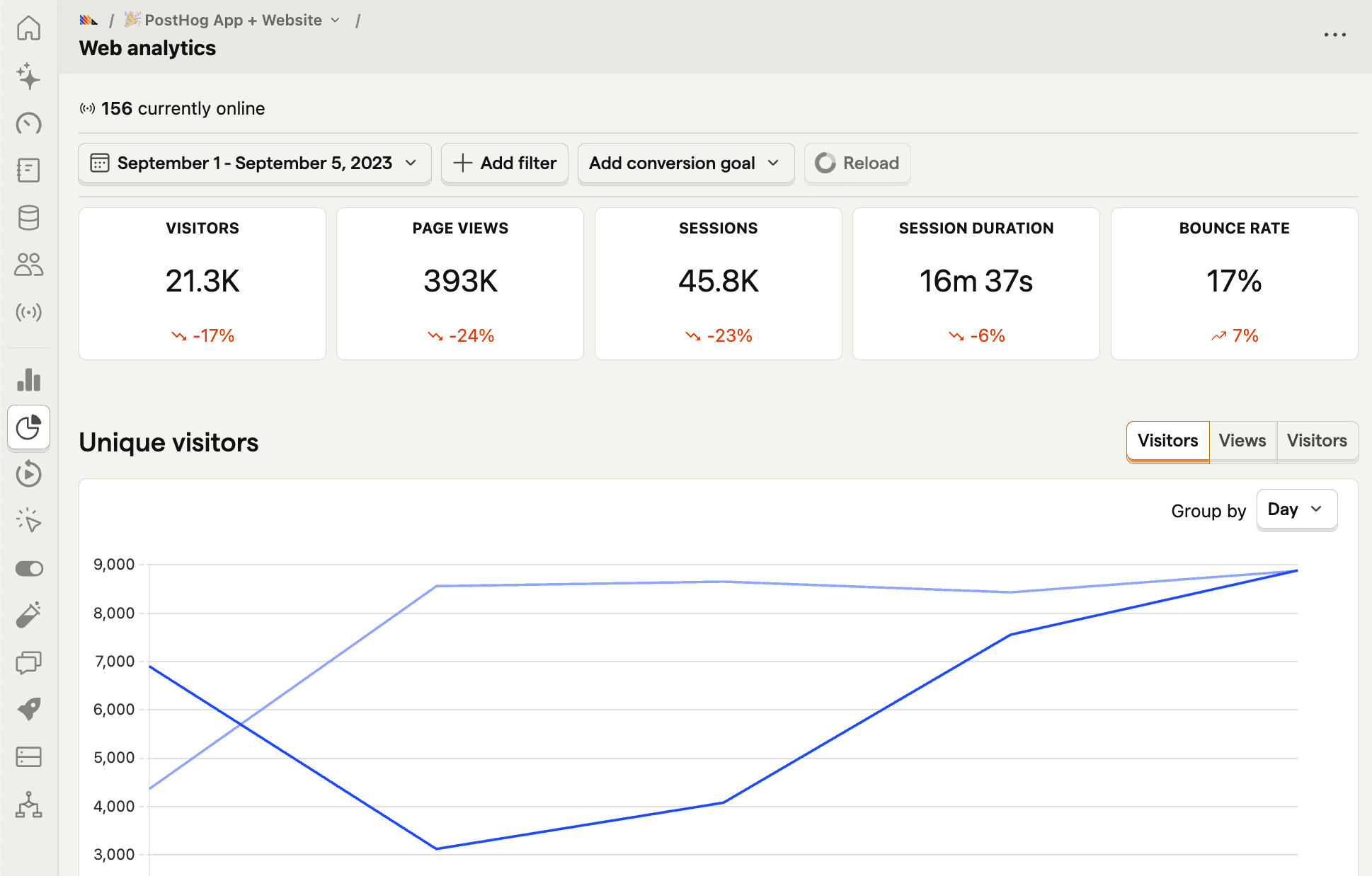

What is PostHog?
PostHog (that's us 👋) is an open-source platform combining web analytics, product analytics, session replay, A/B testing, feature flags, and user surveys into one product. This means it's not only an alternative to Plausible but also tools like Mixpanel, Hotjar, and LaunchDarkly.
According to BuiltWith, as of October 2024, 5,330 of the top 1 million websites deploy PostHog, significantly more than the 3,500 using Plausible.
Key features
📊 Web analytics: Monitor your web traffic by automatically capturing and calculating metrics like visitors, pageviews, session duration, and bounce rate. See the sources, entry and exit paths, channels, and more.
📈 Product analytics: Custom trends, funnels, user paths, retention analysis, and segment user cohorts. Also, direct SQL querying for power users.
📺 Session replays: View exactly how users are using your site. Includes event timelines, console logs, network activity, and 90-day data retention.
💬 Surveys: Target surveys by event or user properties. Templates for net promoter score (NPS), product-market fit (PMF) surveys, and more.
🧪 A/B tests: Optimize your app and website with up to nine test variations and track impact on primary and secondary metrics. Automatically calculate test duration, sample size, and statistical significance.
How does PostHog compare to Plausible?
Plausible focuses on web analytics. PostHog includes web analytics but also offers a full suite of tools to help you build a better site and product. On top of this, you can use all of the features of PostHog for free forever. Plausible costs a minimum of $9/month.
| PostHog | Plausible | |
Free tier Free forever option, no credit card required | ✔ | ✖ |
Web analytics Pre-built dashboard of aggregate traffic, sources, campaigns, and session metrics | ✔ | ✔ |
Conversions Track conversions towards a goal metric with funnels | ✔ | ✔ |
Open source Audit code, contribute to roadmap, and build integrations | ✔ | ✔ |
EU hosting Store your data in the EU for compliance | ✔ | ✔ |
Cookieless tracking Option to track without using cookies | ✔ | ✔ |
Product analytics Create custom dashboards, trends, funnels, paths, and retention | ✔ | ✖ |
Custom events Manually capture custom events and properties wherever they happen | ✔ | ✔ |
User profiles Capture and analyze data at the user-level | ✔ | ✖ |
Cohort analysis Combine users into cohorts for analysis | ✔ | ✖ |
Session replay Watch real users on your site; discover friction points | ✔ | ✖ |
Reverse proxy Official instructions to capture more accurate data by avoiding tracking blockers | ✔ | ✔ |
Why do companies use PostHog?
According to reviews on G2, companies use PostHog because:
It replaces multiple tools: PostHog can replace Plausible (web analytics), Amplitude (product analytics), and Fullstory (session replay). This simplifies workflows and ensures product data is all in one place.
Pricing is transparent and scalable: Reviewers appreciate how PostHog's pricing scales as they grow. There's a generous free tier they can use forever. Companies eligible for PostHog for Startups also get $50k in additional free credits.
They need a complete picture of users: PostHog includes every tool necessary to understand users and improve products. This means creating funnels to track conversion, watching replays to see where users get stuck, testing solutions with A/B tests, and gathering feedback with user surveys.
Bottom line
Because PostHog is free, has web analytics and more, and still has the privacy and compliance features Plausible offers, it makes for a great alternative, especially for developers and startups.
2. Fathom
- Founded: 2018
- Similar to: Plausible, Google Analytics
- Typical users: Founders and content teams
- Typical customers: Privacy-conscious, content-focused websites
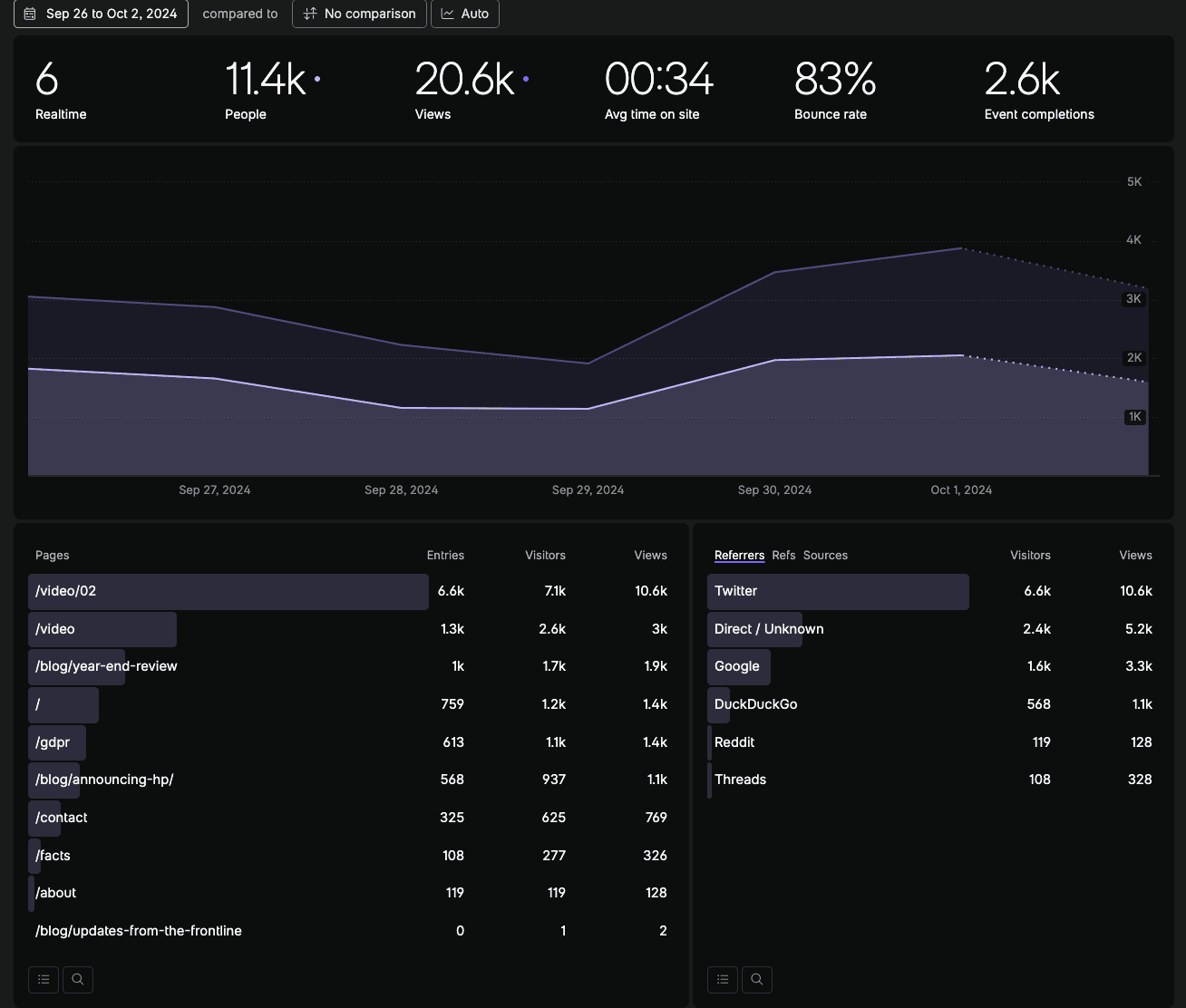
What is Fathom?
Fathom is a privacy-focused Google Analytics alternative. It is a simple web analytics tool that captures details on traffic, sessions, referrers, sources, and campaigns. It does this while helping users stay compliant and avoid cookies.
According to BuiltWith, as of October 2024, 1,832 of the top 1 million websites deploy Fathom. This is just under half of Plausible's 3,500.
Key features
🧑🎨 Simple web analytics: Fathom provides a simple, GA-like experience to monitor your website and get an overview of your traffic.
🍪 Cookieless: Avoid cookie banners and track your site without using cookies.
📊 Marketing metrics: Track the sources, devices, browsers, locations, UTMs, and more for your traffic.
⭐ Conversions: Track custom events and analyze them as conversions towards a goal.
How does Fathom compare to Plausible?
Feature-wise, Plausible and Fathom are nearly identical. Looking closer, however, Fathom is missing some of the compliance features Plausible offers, like open source code.
| Fathom | Plausible | |
Free tier Free forever option, no credit card required | ✖ | ✖ |
Web analytics Pre-built dashboard of aggregate traffic, sources, campaigns, and session metrics | ✔ | ✔ |
Conversions Track conversions towards a goal metric with funnels | ✔ | ✔ |
Open source Audit code, contribute to roadmap, and build integrations | ✖ | ✔ |
EU hosting Store your data in the EU for compliance | ✔ | ✔ |
Cookieless tracking Option to track without using cookies | ✔ | ✔ |
Product analytics Create custom dashboards, trends, funnels, paths, and retention | ✖ | ✖ |
Custom events Manually capture custom events and properties wherever they happen | Events only | ✔ |
User profiles Capture and analyze data at the user-level | ✖ | ✖ |
Cohort analysis Combine users into cohorts for analysis | ✖ | ✖ |
Session replay Watch real users on your site; discover friction points | ✖ | ✖ |
Reverse proxy Official instructions to capture more accurate data by avoiding tracking blockers | ✖ | ✔ |
💡 Good to know: Fathom isn't entirely EU hosted, but instead attempts to stay compliant with European regulation by:
- Being a Canadian company. The European Commission determined that Canada has an adequate level of data protection.
- Having EU isolation so visitor data is routed and stored on EU servers.
- Having a data processing agreement (DPA) available.
Why do companies use Fathom?
Fathom has limited reviews on G2, but much more praise on social. Judging from social posts, the main reasons people choose Fathom are:
Privacy-focus: Fathom reviewers almost always praise its focus on privacy. This allows users to stay compliant with regulations like GDPR, CCPA, and more.
Ease of use: Reviewers find Fathom is simple to set up and simple to understand. Less technical users find this especially helpful.
Migration from GA: Thanks to both its Google Analytics importer and its relatively similar interface, reviewers find the migration from GA to Fathom relatively easy.
Bottom line
Fathom and Plausible both provide a simple web analytics experience. Depending on your regulatory needs, it is one to consider, but it is missing some of the features users choose Plausible for.
3. Matomo
- Founded: 2007
- Similar to: Piwik Pro, Google Analytics
- Typical users: Marketing and ecommerce teams
- Typical customers: Privacy-focused former GA users
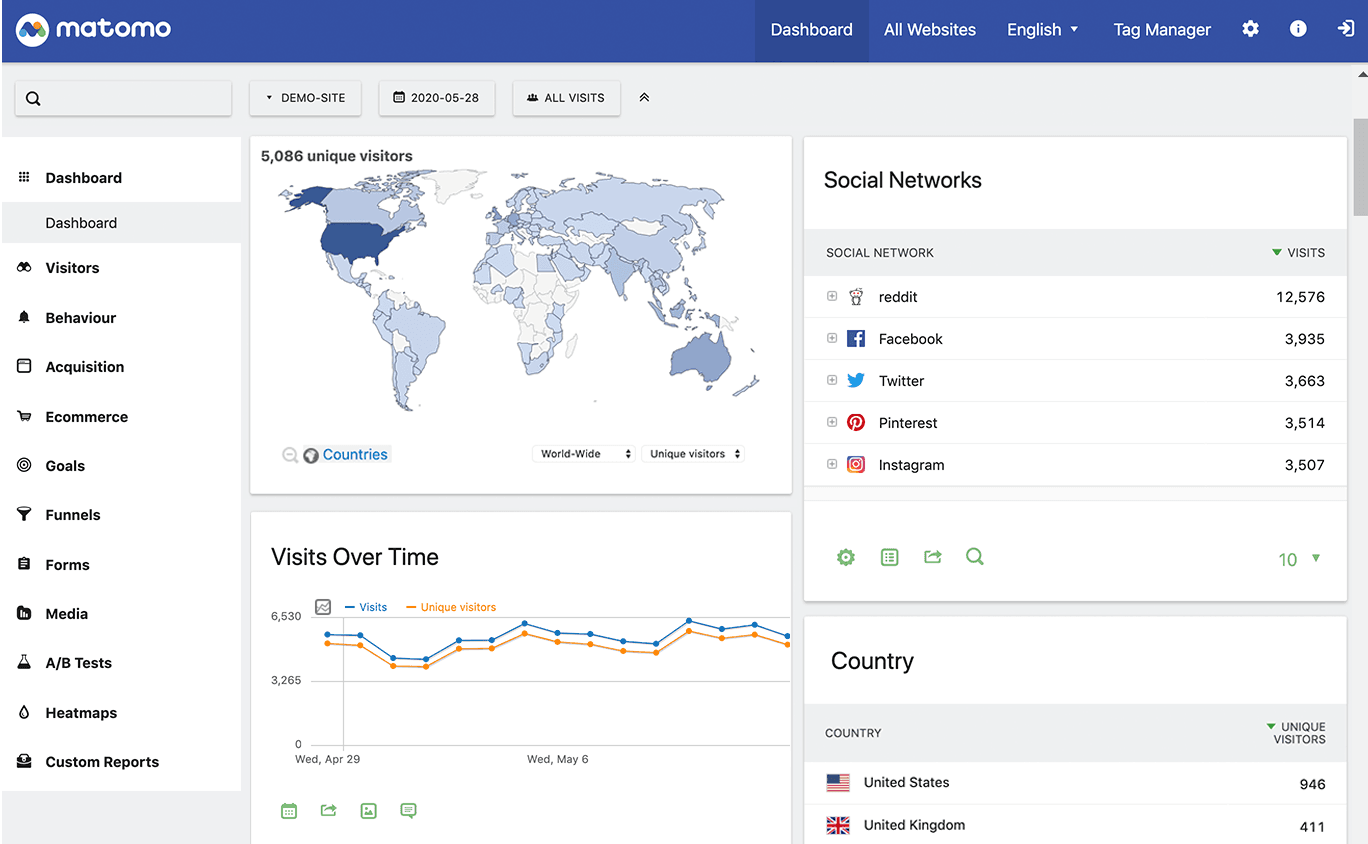
What is Matomo?
Matomo is a fully-featured, privacy-focused Google Analytics alternative. It contains basic web analytics along with more advanced product and behavioral analytics features. This includes features like funnels, cohorts, session recordings, and heatmaps.
According to BuiltWith, as of October 2024, 20,816 of the top 1 million websites deploy Matomo. This is nearly seven times more than the 3,500 who use Plausible.
Key features
🌐 Web analytics: Get an overview of your traffic, popular pages, sources, referrers, and more.
📊 Custom reports: Get detailed reports on product usage, cohorts, funnels, and conversion goals.
📋 Marketing analysis: Combine traffic insights with channel attribution, keyword data, ad performance, and more.
💸 Ecommerce: Integrate with popular ecommerce platforms and track sales, products, and conversions.
How does Matomo compare to Plausible?
Matomo is more of a like-for-like alternative to Google Analytics, meaning it has many more features than Plausible. Both are also privacy-focused, open source, and only have trials, not free tiers.
| Matomo | Plausible | |
Free tier Free forever option, no credit card required | ✖ | ✖ |
Web analytics Pre-built dashboard of aggregate traffic, sources, campaigns, and session metrics | ✔ | ✔ |
Conversions Track conversions towards a goal metric with funnels | ✔ | ✔ |
Open source Audit code, contribute to roadmap, and build integrations | ✔ | ✔ |
EU hosting Store your data in the EU for compliance | ✔ | ✔ |
Cookieless tracking Option to track without using cookies | ✔ | ✔ |
Product analytics Create custom dashboards, trends, funnels, paths, and retention | ✔ | ✖ |
Custom events Manually capture custom events and properties wherever they happen | ✔ | ✔ |
User profiles Capture and analyze data at the user-level | ✔ | ✖ |
Cohort analysis Combine users into cohorts for analysis | ✔ | ✖ |
Session replay Watch real users on your site; discover friction points | ✔ | ✖ |
Reverse proxy Official instructions to capture more accurate data by avoiding tracking blockers | ✖ | ✔ |
Why do companies use Matomo?
According to reviews on G2, people choose Matomo because:
On-premise: Reviews appreciate that Matomo can be hosted and run from your own servers, keeping them in full control of their data.
Privacy: Matomo is open-source, self-hostable, and community-focused. The combination of these creates a privacy-focused platform reviewers appreciate.
GA-like: Matomo's feature set is very similar to Google Analytics. This means users can do the analysis they are familiar with on a more privacy-friendly platform.
Bottom line
Matomo is a solid alternative to Plausible thanks to its similar, but expanded feature set and focus on privacy. For advanced Google Analytics users, it's an especially good choice.
4. Heap
- Founded: 2013
- Similar to: PostHog, LogRocket
- Typical users: Product and marketing teams
- Typical customers: B2C SaaS and ecommerce companies with a user experience focus.

What is Heap?
Heap describes itself as a digital insights platform. This means it offers both product analytics and session replay and supports marketing use cases with multi-touch attribution. Contentsquare, a marketing and ecommerce analytics firm, acquired Heap in September 2023 and announced plans to integrate the two products.
According to BuiltWith, a similar number of users deploy both Heap and Plausible. As of October 2024, 2,824 of the top 1 million websites deploy Heap while 3,500 use Plausible.
Key features
✅ Event autocapture: Product teams don't need to rely on engineers to instrument all events. Heap has a visual editor for teams to tag events directly on-page for analysis.
📺 Session replay: Get qualitative insights about user behavior by replaying their session - although this lacks the debugging tools typical of most replay tools.
🔥 Heatmaps: See where people click, what point they scroll to, and the areas that get the most attention.
🤖 Analysis suggestions: Advanced data science capabilities discover hidden interactions, friction points, and knowledge about key paths.
🔁 Managed ETL: Connect to data warehouses, so you can combine your analytics with other sources and get a fuller picture of the entire user journey.
How does Heap compare to Plausible?
Heap has much more of a product focus than Plausible. This means it lacks the easy-to-use web analytics features, but makes up for it with product analytics, session replay, and more. It also isn't open source or hostable in the EU.
| Heap | Plausible | |
Free tier Free forever option, no credit card required | ✔ | ✖ |
Web analytics Pre-built dashboard of aggregate traffic, sources, campaigns, and session metrics | ✖ | ✔ |
Conversions Track conversions towards a goal metric with funnels | ✔ | ✔ |
Open source Audit code, contribute to roadmap, and build integrations | ✖ | ✔ |
EU hosting Store your data in the EU for compliance | ✖ | ✔ |
Cookieless tracking Option to track without using cookies | ✖ | ✔ |
Product analytics Create custom dashboards, trends, funnels, paths, and retention | ✔ | ✖ |
Custom events Manually capture custom events and properties wherever they happen | ✔ | ✔ |
User profiles Capture and analyze data at the user-level | ✔ | ✖ |
Cohort analysis Combine users into cohorts for analysis | ✔ | ✖ |
Session replay Watch real users on your site; discover friction points | ✔ | ✖ |
Reverse proxy Official instructions to capture more accurate data by avoiding tracking blockers | ✖ | ✔ |
Why do companies use Heap?
According to G2 reviews, companies enjoy these three areas of Heap:
Autocapture: Non-technical users love how easy autocapture makes tracking on their site. Along with the element data included, this provides a huge amount of useful analytics data with little setup.
Simple setup: It does not take a big technical effort to set Heap up. Users can add a single script and begin collecting data. They then make it easy to visualize that data through user paths, funnels, and session replays.
Streamlining analysis: By having analytics and session replay data in one place, Heap makes it easy to understand the usage of their app or site. This replaces interviews or user testing and makes the development cycle faster.
Bottom line
Heap is a good alternative for teams focused on improving their product. For web or privacy-focused teams, there are likely better options.
5. Piwik Pro
- Founded: 2013
- Similar to: Matomo, Google Analytics
- Typical users: Marketing and analysis teams
- Typical customers: European enterprises in strict regulatory situations

What is Piwik Pro?
Piwik Pro is a suite of privacy respecting analytics tools. These include web, mobile, and product analytics as well as tag and consent management. It is targeted at users in a strict regulatory environment.
Piwik Pro spun out as a paid fork of Matomo in 2013. Since then, it has added compliance-focused features as well as a range of integrations with tools like Looker, Google Search Console, and Google Ads.
According to BuiltWith, as of October 2024, 1,902 of the top 1 million websites deploy Piwik Pro. 3,500 use Plausible.
Key features
📈 Analytics: Create custom dashboards with trends, charts, flows, funnels, and more to analyze your analytics.
🏷️ Tag manager: Manage tags, pixels, and JavaScript snippets from a range of platforms.
🙅 Consent manager: Collect and manage consent to track and use personal information. Customize and tailor banners for different situations.
💽 Customer data platform: Integrate with other tools and capture data to have it all in one place. Send data from Piwik Pro to other tools.
How does Piwik Pro compare to Plausible?
Piwik Pro takes a more heavyweight approach to compliance with its consent and tag management features.
| Piwik Pro | Plausible | |
Free tier Free forever option, no credit card required | ✔ | ✖ |
Web analytics Pre-built dashboard of aggregate traffic, sources, campaigns, and session metrics | ✔ | ✔ |
Conversions Track conversions towards a goal metric with funnels | ✔ | ✔ |
Open source Audit code, contribute to roadmap, and build integrations | ✖ | ✔ |
EU hosting Store your data in the EU for compliance | ✔ | ✔ |
Cookieless tracking Option to track without using cookies | ✔ | ✔ |
Product analytics Create custom dashboards, trends, funnels, paths, and retention | ✔ | ✖ |
Custom events Manually capture custom events and properties wherever they happen | ✔ | ✔ |
User profiles Capture and analyze data at the user-level | ✔ | ✖ |
Cohort analysis Combine users into cohorts for analysis | ✔ | ✖ |
Session replay Watch real users on your site; discover friction points | ✖ | ✖ |
Reverse proxy Official instructions to capture more accurate data by avoiding tracking blockers | ✔ | ✔ |
Why do companies use Piwik Pro?
Based on reviews from G2, the following summarizes of reasons why users choose Piwik Pro:
GA-like: Google Analytics users find that the transition to Piwik Pro is an easy one thanks to their similar dashboards and data models.
Compliance: Those in strict regulatory environments appreciate how Piwik Pro provides many of the tools they need to stay compliant like tag and consent management.
Control: Reviewers like that they are in control of their data, tune it to their needs, and host it outside the US.
Bottom line
For users looking for the compliance features Piwik Pro offers, it's a good alternative to Plausible, especially because of Piwik Pro's free tier and privacy focus.
6. Umami
- Founded: 2022
- Similar to: Fathom, Plausible
- Typical users: Developers and content-focused teams
- Typical customers: Small devs and large content-focused enterprises
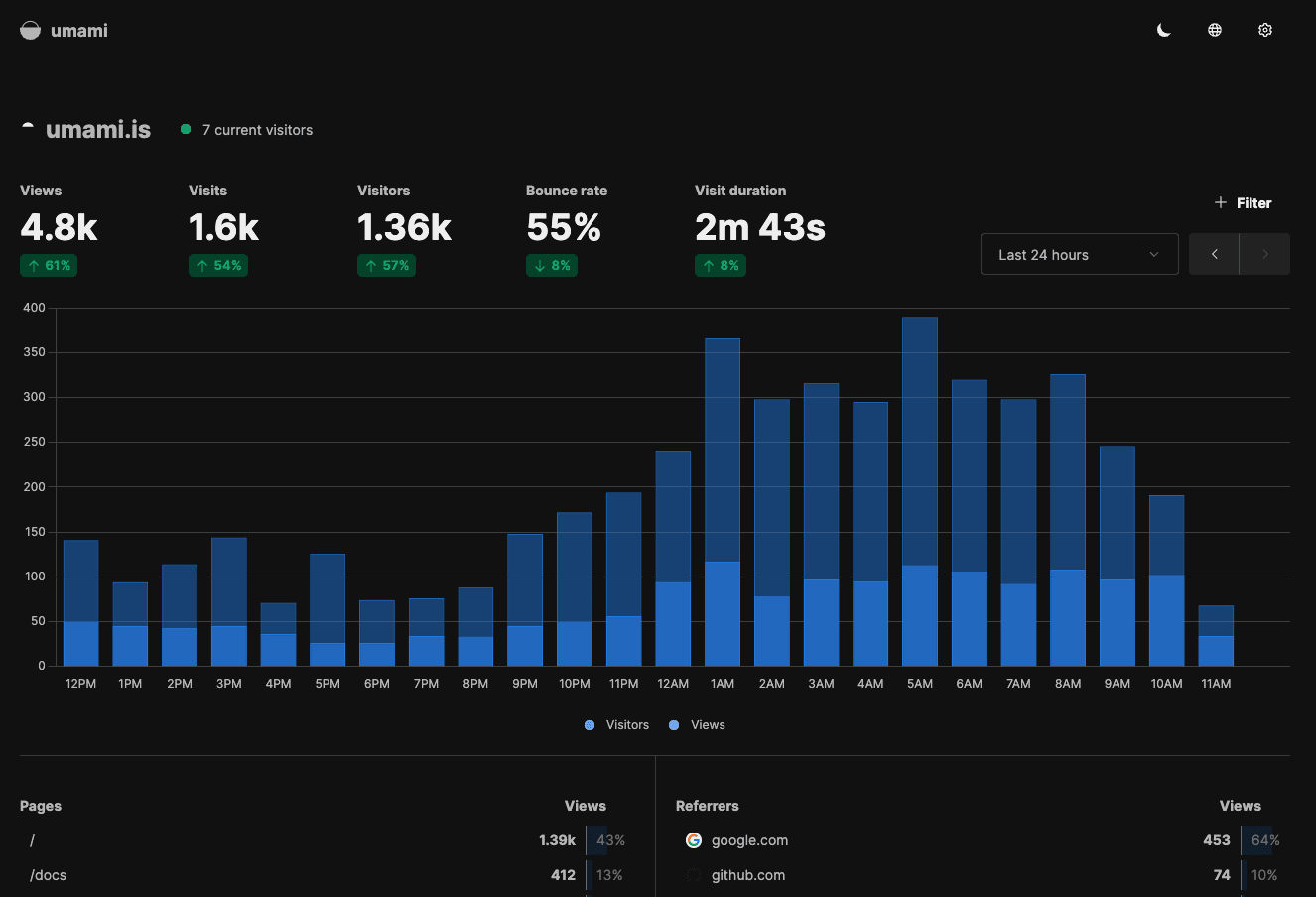
What is Umami?
Umami is an open source, easy-to-use Google Analytics alternatives. Like other similar tools, it is privacy friendly. This means data is anonymized, no personal data is saved, you don't need a cookie banner, and comply with GDPR.
According to BuiltWith, as of October 2024, 1,077 of the top 1 million websites deploy Umami. Plausible is more than three times more popular with 3,500 sites using it.
Key features
🌍 Visitor insights: Breakdown the sources of your traffic. See the browsers, locations, devices, and OS they use.
🛠️ Custom events: Track more than pageviews. Capture custom events wherever they happen on your site.
📖 Open source: See all of the code, run and host it yourself, modify it for your needs, and contribute to it.
🏃 Realtime: Get a view into the live stats for your site. See how many current vistiors you have.
How does Umami compare to Plausible?
Umami is one of the most similar tools to Plausible on this list. It is open source, privacy focused, and even has a similar metrics dashboard. While it does lack some of the features of Plausible, Umami does have a free cloud hosted option.
| Umami | Plausible | |
Free tier Free forever option, no credit card required | ✔ | ✖ |
Web analytics Pre-built dashboard of aggregate traffic, sources, campaigns, and session metrics | ✔ | ✔ |
Conversions Track conversions towards a goal metric with funnels | ✖ | ✔ |
Open source Audit code, contribute to roadmap, and build integrations | ✔ | ✔ |
EU hosting Store your data in the EU for compliance | ✖ | ✔ |
Cookieless tracking Option to track without using cookies | ✔ | ✔ |
Product analytics Create custom dashboards, trends, funnels, paths, and retention | ✖ | ✖ |
Custom events Manually capture custom events and properties wherever they happen | Events only | ✔ |
User profiles Capture and analyze data at the user-level | ✖ | ✖ |
Cohort analysis Combine users into cohorts for analysis | ✖ | ✖ |
Session replay Watch real users on your site; discover friction points | ✖ | ✖ |
Reverse proxy Official instructions to capture more accurate data by avoiding tracking blockers | ✖ | ✔ |
Why do companies use Umami?
According to its few G2 reviews and mentions on social, users choose Umami because of:
Simple setup: Reviewers find that Umami is easy to setup, self-host, and add to their site.
Free plan: Users appreciate they can use Umami for 3 sites and 100k events for free.
Minimal design: Umami's clean and simple UI is a selling point for some reviewers.
Bottom line
Umami is a like-for-like alternative to Plausible. For users looking for a privacy-focused, open source, and simple web analytics tool, it's a good choice.
7. Google Analytics
- Founded: 2005
- Similar to: Matomo, Piwik Pro
- Typical users: Marketing and business teams reliant on Google's ecosystem
- Typical customers: Small businesses and massive enterprises
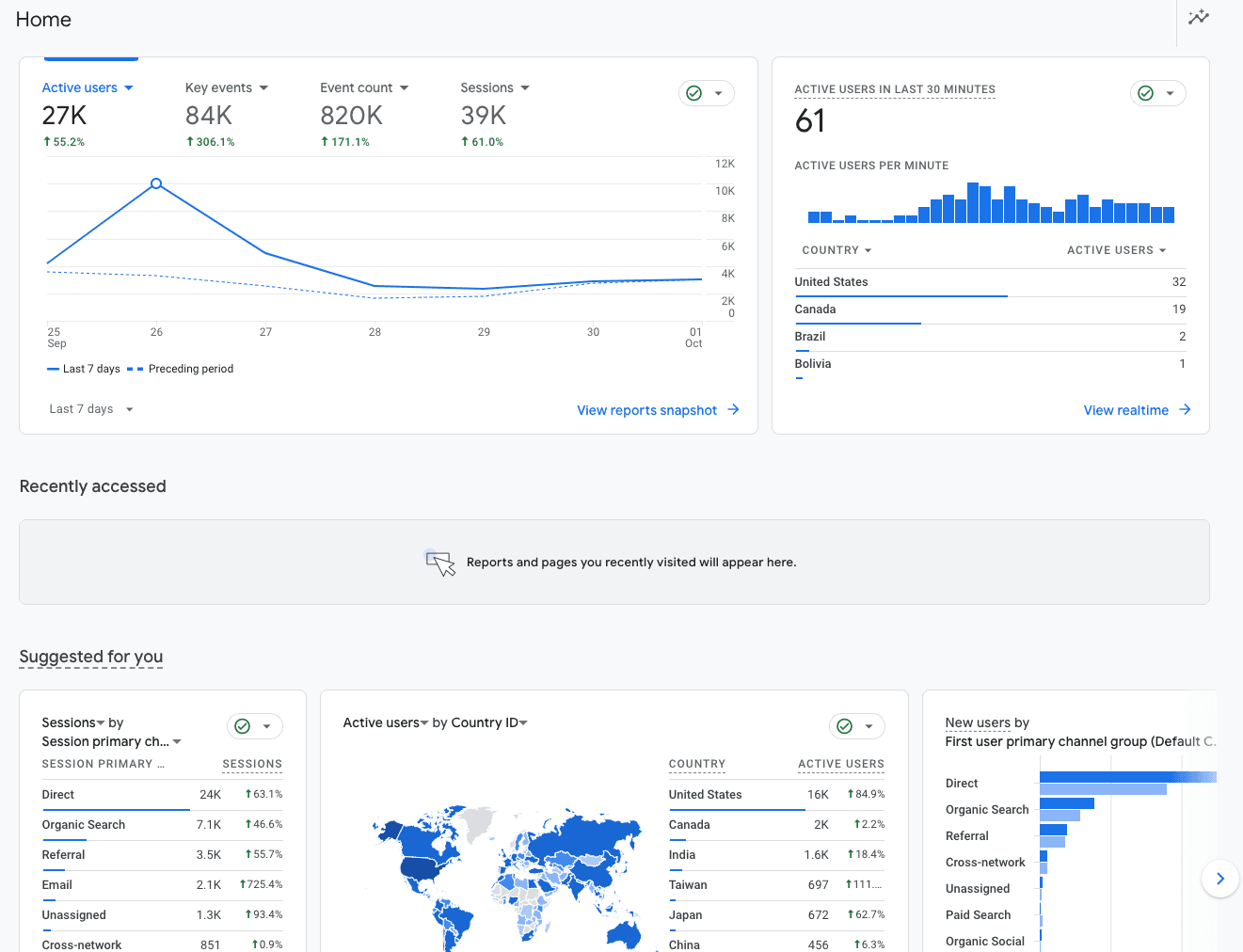
What is Google Analytics?
Google Analytics has long been the go-to choice for website and app analytics thanks to Google's huge market share, a large amount of informational content, and its connection with the rest of the Google suite.
Google Analytics recently switched fully over from session-based Universal Analytics (GA3) to event-based GA4. This also introduced conversion funnels and retention tables that product teams are fans of.
According to BuiltWith, as of October 2024, a whopping 489,524 of the top 1 million websites deploy Google Analytics. Massively more than the 3,500 using Plausible.
Key features
📊 Flexible reporting: GA has pre-built insights as well as fully customizable ones to fit your reporting requirements.
🤖 Predictive insights: Alert you to trends you're not aware of, like an increase in traffic to a specific landing page, or an anomalous decline in conversion from one period to another.
🔁 Integration with Google tools: It's easy to combine and analyze your GA4 data with tools like Looker Studio, Google Ads, BigQuery, and Firebase.
⌨️ Natural language search: Ask specific questions, like "MoM growth in users on iOS", rather than searching existing reports.
💸 Revenue metrics: Connect metrics to marketing spend and revenue conversion to get a full picture of ROI.
How does Google Analytics compare to Plausible?
Plausible positions itself as a privacy-focused alternative to Google Analytics. It doesn't have as many features, but for many users, the privacy trade-off is worth it.
| Google Analytics | Plausible | |
Free tier Free forever option, no credit card required | ✔ | ✖ |
Web analytics Pre-built dashboard of aggregate traffic, sources, campaigns, and session metrics | ✔ | ✔ |
Conversions Track conversions towards a goal metric with funnels | ✔ | ✔ |
Open source Audit code, contribute to roadmap, and build integrations | ✖ | ✔ |
EU hosting Store your data in the EU for compliance | ✖ | ✔ |
Cookieless tracking Option to track without using cookies | ✖ | ✔ |
Product analytics Create custom dashboards, trends, funnels, paths, and retention | ✔ | ✖ |
Custom events Manually capture custom events and properties wherever they happen | ✔ | ✔ |
User profiles Capture and analyze data at the user-level | ✔ | ✖ |
Cohort analysis Combine users into cohorts for analysis | ✔ | ✖ |
Session replay Watch real users on your site; discover friction points | ✖ | ✖ |
Reverse proxy Official instructions to capture more accurate data by avoiding tracking blockers | ✖ | ✔ |
Why do companies use Google Analytics?
According to G2, users choose Google Analytics for:
Website traffic: The main use case reviewers praise GA for simply understanding their website's traffic, where it comes from, and what they do on the site.
Connection to marketing: Marketers like that it connects to marketing tools like Ads and Search Console. This helps them analyze the overall effectiveness of marketing efforts.
AI insights: Reviewers appreciate the fact that GA surfaces insights automatically and makes predictions. This helps them find new ways of improving their site.
Bottom line
Google Analytics is the default web analytics tool for many teams. Its integrations with other Google tools make it hard to beat for users reliant on that ecosystem. For privacy-focused teams, or ones looking for an easy-to-use tool, there are better options.
Is PostHog right for you?
Here's the (short) sales pitch.
We're biased, obviously, but we think PostHog is the perfect Plausible replacement if:
- You want all the tools to help you build a better product (like product analytics and session replays).
- You want to try before you buy. We're self-serve with a generous free tier.
- You value transparency. We're open source and open core.
Check out our product pages and read our docs to learn more.
